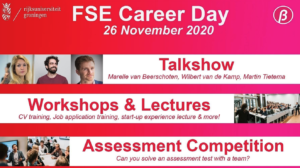
ICD lectures during FSE Career Day
News | December 2, 2020
No less than 75 students from the Faculty of Science and Engineering took part in the ICD lectures by Onno Hoitinga, Joost Krebbekx and Gerrit Baarda on 26 November during the 2020 edition of FSE Career Day.

Every year, the Faculty of Science and Engineering (FSE) of the University of Groningen organizes the Career Day. Master's students and third-year bachelors get an idea of the jobs that match their interests and talents. In addition, special workshops and interactive presentations allow them to develop their employability skills.
This year Innovatiecluster Drachten presented three lectures. Onno Hoitinga, head of development at the Male Grooming Innovation Team at Philips, told the students with practical examples that the future is closer than you think. Joost Krebbekx, program manager ICD, showed how innovative high-tech companies work together without competing with each other. And Gerrit Baarda, founder and owner of ZIUZ Visual Intelligence, talked about how to make a high-tech start-up successful.
Read the short report of the first lecture below. Knowing more? Then visit the website of the FSE Career Day
FSE Career Day: The future is closer than you can imagine
Not only in time, but also in distance, the digital future is much closer than we think. 'What we only dreamed about until recently is already happening all around us', begins Onno Hoitinga his lecture.
He refers to the merging of the physical and digital worlds. For example with augmented reality and serious gaming. Hoitinga sees a similar trend in people who are supported with exoskeletons, for example to do heavy work or to rehabilitate. Or look-a-like robots that work on the same products together with people. And cobots that do the heavy lifting in the car industry. But also fully automatic machines that can be operated without human operation.
Moore's Law

The driver for these developments is according to Hoitinga Moore's Law. “Mobile phones are just as powerful now as the big computers of a few years ago. That's because high-tech is now affordable and, moreover, good and cheap to produce.' Many people therefore have the most advanced technology at home. 'Look at 3D printers. Previously extremely expensive and very difficult to operate, today schools and hobbyists have one. Everyone can therefore easily devise new applications and those who are handy can also make them themselves. Such as, for example Harshwardhan Zala, a 14-year-old boy from India, who designed a drone to destroy land mines. This used to be the preserve of the smartest engineers, with access to advanced technology.'
Digital Twin
Hoitinga gives a good example of the fusion of the physical with the digital world by means of the virtual twin of physical reality. 'A so-called Digital Twin can be made with data. For example, to experiment with crash tests for cars. It is not only much cheaper to drive cars into a wall in a digital environment. It also shortens the time to market. The result is that products can be adapted much faster to new insights or questions from the market.'
swarms
Besides 3D printing, neural networks and sensor technology, Hoitinga sees another important trend. Linking huge amounts of data to connected systems that, directly or indirectly, connect everything around the world. 'Because data is shared and becomes available for analysis, it can be used for all kinds of applications. For example, consider industrial issues to improve production processes or adapt products to current market demand.' But data can also be linked to autonomous systems, according to Hoitinga. 'For example, drones that fly autonomously and that are linked to each other with swarm technology, so that they can perform functions that are difficult or impossible for humans. For example in areas where a natural disaster takes place or in places where people cannot reach because the circumstances are life-threatening.'
deep fake
To conclude his lecture, Hoitinga discussed photonics, also known as visual intelligence or facial recognition. 'Optical elements are becoming increasingly important in our daily lives. Look at lasers and image sensors, which are accessible to everyone thanks in part to smartphones. This allows us, for example, to recognize faces with many new applications, such as personal care and identification. The downside of this technique is Deep fake videos. Arjan Lubach showed that this technique can be dangerous if we can no longer distinguish fake from real.'